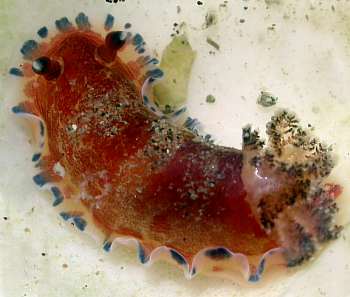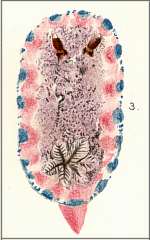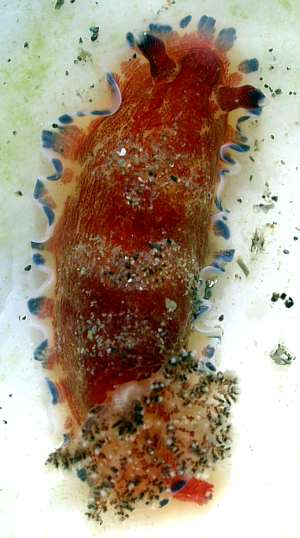

Dendrodoris elizabethina
(Kelaart, 1859)
Order: NUDIBRANCHIA
Suborder: DORIDINA
Superfamily: EUDORIDOIDEA
Family: Dendrodorididae
DISTRIBUTION
Known only from Sri Lanka and Gulf of Oman
PHOTO
Upper: On algae in a sandy tidal channel bordered by mangroves, 25cm at low tide, 1.5 - 2cm long. Locality: Khawr Kalba, United Arab Emirates, Gulf of Oman, 16 Feb. 2004. Photo: Henk Dekker
Lower: Painting from Kelaart's collection from Eliot (1906) - Plate XLIII, Fig. 3. Doris elizabethina.
The mantle is translucent with mottled reddish brown pigmentation all over the central region of the mantle. The mantle skirt is relatively narrow and thrown into waves around the edge. This region is translucent clear with scattered large reddish spots of varying size. Right at the edge are large blue patches. The foot is translucent white with reddish spots and a broad red median band down the posterior tip. The rhinophore stalk and basal hallf of the club is reddish brown and the upper half of the club is black with a white tip. The gills are translucent clear with black specks edging the branches.
This species was described from Ceylon (Kelaart, 1859). The original description is transcribed below. Eliot (1906) published a colour painting from Kelaart's collections which is also copied in the accompanying illustrations.
"Body half an inch long. Mantle broad, spotted with purple on the back; margin white, spotted with large light-blue spots. A row of crimson spots between the line of blue spots and the purple-coloured back. Under surface of mantle whitish, with a pink shade. Tentacles purplish brown, white tipped, laminated. Branchiae six, small, bipinnated, of a grizzled grey colour. Foot whitish upper surface crimson. Mouth with a small veil. This elegantly coloured Doris was obtained in deep water near the Pearl Banks of Aripo. I have named it in compliment to one who takes more than an ordinary interest in my zoological pursuits." Kelaart, 1859 p. 267.
See separate discussion on its identity [#12367].
See Dendrodoris caesia, which is possibly a junior synonym.
References:
• Kelaart, E.F. (1859). On some additional species of nudibranchiate mollusks from Ceylon. Annals & Magazine of Natural History, 4: 267-270
• Eliot, C.N.E. (1906) On the nudibranchs of Southern India and Ceylon, with special reference to the drawings by Kelaart and the collections belonging to Alder & Hancock preserved in the Hancock Museum at Newcastle-on-Tyne. Proceedings of the Zoological Society of London, [for 1906] 2: 636-691. (Pls. 42-47). [Plate XLIII. Fig. 3 Doris elizabethina
• Eliot, C.N.E. (1907) On the nudibranchs of Southern India and Ceylon, with special reference to the drawings by Kelaart and the collections belonging to Alder and Hancock, preserved in the Hancock Museum at Newcastle-on-Tyne, No. 2. Proceedings of the Zoological Society of London [for 1906]: 999-1008.
Rudman, W.B., 2004 (March 2) Dendrodoris elizabethina (Kelaart, 1859). [In] Sea Slug Forum. Australian Museum, Sydney. Available from http://www.seaslugforum.net/find/dendeliz
Related messages
Dendrodoris elizabethina from Gulf of Oman
March 5, 2004
From: Henk Dekker

This dorid-like species is 1.5 - 2cm long. It was collected in 25 cm of water at low tide, on algae in a sandy tidal channel bordered by mangroves. Locality: United Arab Emirates, Gulf of Oman, Khawr Kalba. 16 Feb. 2004. Any ideas on the identity are welcome.
Henk Dekker
h-dekker@quicknet.nl
Dekker, H., 2004 (Mar 5) Dendrodoris elizabethina from Gulf of Oman. [Message in] Sea Slug Forum. Australian Museum, Sydney. Available from http://www.seaslugforum.net/find/12327
Dear Henk,
This is a very interesting find, as I have discussed in a separate message [#12367]. From the general shape of your animal it is clearly a species of Dendrodoris but the only species that looks vaguely like it is Dendrodoris caesia from South Africa. However as soon as I saw it I was reminded of a painting of an animal collected in Sri Lanka [Ceylon] almost 150 years ago and never seen since. As I discuss separately, I am sure that your animal is the long lost Doris elizabethina, which is best placed in the genus Dendrodoris. I am not sure who Elizabeth was, but from Kelaart's comments " ... I have named it in compliment to one who takes more than an ordinary interest in my zoological pursuits." , it sounds as thought here was romance in the air.
Best wishes
Bill Rudman
Rediscovery of Doris elizabethina Kelaart
March 5, 2004
From: Bill Rudman


PHOTOS: Upper: On algae in a sandy tidal channel bordered by mangroves, 25cm at low tide, 1.5 - 2cm long. Locality: Khawr Kalba, United Arab Emirates, Gulf of Oman, 16 Feb. 2004. Photo: Henk Dekker
Lower: Painting from Kelaart's collection from Eliot (1906) - Plate XLIII, Fig. 3. Doris elizabethina.
The external colour of this species was described from Ceylon (Kelaart, 1859) and Eliot (1906) subsequently published a colour plate from Kelaart's collections. In a second part of his review of Kelaart's species (Eliot, 1907), Eliot noted that although this species had the appearance of a chromodorid, the mantle was quite wide and the branched gills were abnormal for that family. Since that time no similarly coloured animal has been described from the Indian Ocean, until Henk Dekker's message [#12327] from the Gulf of Oman.
The animal in Dekker's photo matches Kelaart's painting in all respects, the only minor variation being that in Kelaart's painting the posterior foot is all a reddish colour, while in Dekker's animal the posterior part of the foot is translucent white with a broad reddish band down the midline.
Copied here is Kelaart's full description:
Body half an inch long. Mantle broad, spotted with purple on the back; margin white, spotted with large light-blue spots. A row of crimson spots between the line of blue spots and the purple-coloured back. Under surface of mantle whitish, with a pink shade. Tentacles purplish brown, white tipped, laminated. Branchiae six, small, bipinnated, of a grizzled grey colour. Foot whitish upper surface crimson. Mouth with a small veil. This elegantly coloured Doris was obtained in deep water near the Pearl Banks of Aripo. I have named it in compliment to one who takes more than an ordinary interest in my zoological pursuits." Kelaart, 1859 p. 267.
I have puzzled over this species for many years. Its colours certainly suggest it is perhaps a chromodorid, but as Eliot suggested, the gills as illustrated, would be unusual in that genus. The similarity between the original painting and Dekker's photos is remarkable and leaves no doubt in my mind that it is the same species. From Dekker's photo there can be little doubt that this is a species of Dendrodoris. Eliot could not find a specimen or radular mount in Kelaart's collection at the Natural History Museum in Newcastle-on-Tyne which is what we might expect if the animal was a species of Dendrodoris, which lack a radula. I have subsequently visited the collection in Newcastle-on-Tyne and was unable to find a specimen or radula mount. The only species of Dendrodoris which approaches this species in colour is the South African species D. caesia, and it is possible that this will prove to be a synonym.
Kelaart's use of the name Doris elizabethina seems to be the earliest use of the name. It should not be confused with Chromodoris elizabethina Bergh, 1875 or Chromdoris elisabethina Bergh, 1877.
References:
• Kelaart, E.F. (1859). On some additional species of nudibranchiate mollusks from Ceylon. Annals & Magazine of Natural History, 4: 267-270
• Eliot, C.N.E. (1906) On the nudibranchs of Southern India and Ceylon, with special reference to the drawings by Kelaart and the collections belonging to Alder & Hancock preserved in the Hancock Museum at Newcastle-on-Tyne. Proceedings of the Zoological Society of London, [for 1906] 2: 636-691. (Pls. 42-47). [Plate XLIII. Fig. 3 Doris elizabethina
• Eliot, C.N.E. (1907) On the nudibranchs of Southern India and Ceylon, with special reference to the drawings by Kelaart and the collections belonging to Alder and Hancock, preserved in the Hancock Museum at Newcastle-on-Tyne, No. 2. Proceedings of the Zoological Society of London [for 1906]: 999-1008.
Best wishes
Bill Rudman
